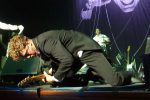Interview: The Hives refuse to go back to roots with new album

The Hives perform at her Warfield in San Francisco on Sept. 10, 2012.
For 2007’s The Black and White Album, Swedish garage rockers The Hives – backed by Interscope Records – brought in a cadre of big-name producers like Pharrell Williams, Jacknife Lee and Timbaland. The quintet always had a headmaster calling the shots.
The Hives, FIDLAR
8 p.m., Sept. 10
Shoreline Amphitheatre in Mountain View
Tickets: $30.
On this year’s, Lex Hives, production work was split among frontman Howlin’ Pelle Almqvist (Per Almqvist), guitarists Nicholaus Arson (brother Niklas Almqvist) and Vigilante Carlstroem (Mikael Karlsson), bassist Dr. Matt Destruction (Mattias Bernvall) and drummer Chris Dangerous (Christian Grahn).
The Hives dealt with having no authority figure the best way they knew how.
“There was a lot of arguing and disagreeing,” said never-shy Howlin’ Pelle in a recent phone chat. “That’s how you make something better. You’re supposed to argue. You don’t argue so much that it breaks up the band, but if you don’t argue at all – and you agree all the time – how are you going to make anything better?”
Almqvist spoke freely about the Hives’ time on a major label, and their new “sideways” direction.
The band signed with Universal-Interscope in 2000 after 1997 debut Barely Legal, 2000 follow-up Veni Vidi Vicious and a compilation of the most popular tracks shined a spotlight in the band’s direction.
Howlin’ Pelle said Interscope fully promoted and supported 2004’s Tyrannosaurus Hives, with singles “Walk Idiot Walk” and “A Little More For Little You,” by integrating songs into commercials and TV shows.
“We didn’t agree to any of that before the Tyrannosaurus Hives album, but it did pretty well, I thought, because of that,” he said. But that support ran dry with Black and White. “They stopped promoting it after two weeks.”
So the band took over the promotional duties, finding television and advertising executives interested in the music. This is why you heard so much of “Tick Tick Boom” while flipping through the channels. The band learned much and enjoyed its time with Interscope, Almqvist said, but it wasn’t the right fit.
“It got kind of tedious hanging out with people who were constantly whining about how the ‘90s were over,” he said. “During the entire time we were there, they were in a constant state of panic over record sales.”
The team of producers brought in drum machines, synthesizers and a high-tech complexity of assembling Black and White, which was, for the band, a much glossier collection of songs.
The Hives are, nevertheless, proud of the album. A multi-year tour followed and did not end until Howlin’ Pelle took a bad fall off some scaffolding that forced a weeks-long hospital detour.
“We did exactly what we wanted to do,” he said. “I think that it was really great. Now that we’ve started touring again, I’ve enjoyed playing those songs live.”
Following Almqvist’s recuperation and some time off, the Hives, now on their own again, got back to the recording studio. The end result was a slightly longer-than-30-minute record, which, “if recorded by some other band…would have been 45 minutes,” the band wrote in some clever promotional material.
While the songs are distinctly Hives, and different from their previous work with Interscope, Almqvist wants to make it clear that Lex Hives is not a return to roots. He said it was a move sideways.
“Bands…that make a back-to-the-roots album are remaking their first album, or a copy of it,” he said. “It makes me kind of bummed out. I hope that’s not what we did. They should make something else instead. (Lex Hives) sounds like a new Hives record.”
Q&A: Howlin’ Pelle Almqvist on the Hives’ mission
I spoke to (drummer) Chris Dangerous in 2007 and remember him commenting how it was interesting to bring in different producers to help with recording that year’s “The Black and White Album,” but he didn’t think you could do it again. Now it’s 2012 and he was right. Does the decision to do everything yourselves this time have anything to do with the experiences you had last time?
Howlin’ Pelle Almqvist: He saw into the future. While recording the Black and White album, it was a much tougher chore to schedule the producers than to actually record with them. The recording sessions generally lasted one day at a time. We recorded songs only a couple of times, which meant that it was minimal, the amount of time that was spent in the recording studio.
Was there a desire to go back to where you came from, in terms of the sound on the album?
Howlin’ Pelle Almqvist: I get depressed about going back to the roots because that’s not what we wanted to do. More than that, we wanted to make an album that was different in the way that we made it from the Black and White album. It was all written in the studio. We spent a lot of time in the studio.
What is the mission statement of The Hives these days? What’s your current goal and where does the band go from here?
Howlin’ Pelle Almqvist: We’re very proud that we produced this album ourselves. We know we can do this ourselves without any other people. We don’t need record companies. We don’t need producers. We don’t need anybody but ourselves, a tape recorder, and a microphone.
On not slowing down their energetic live show:
Howlin’ Pelle Almqvist: We want to do this for the rest of our lives. It’s going to get progressively harder. But Mick Jagger does it.”
When told that Jagger moves horizontally rather than vertically these days:
Howlin’ Pelle Almqvist: I’m going to try to keep it up-and-down for as long as I can.
- The Hives perform at her Warfield in San Francisco on Sept. 10, 2012.
- The Hives perform at her Warfield in San Francisco on Sept. 10, 2012.
- The Hives perform at her Warfield in San Francisco on Sept. 10, 2012.
- The Hives perform at her Warfield in San Francisco on Sept. 10, 2012.
- The Hives perform at her Warfield in San Francisco on Sept. 10, 2012.
- The Hives perform at her Warfield in San Francisco on Sept. 10, 2012.
- The Hives perform at her Warfield in San Francisco on Sept. 10, 2012.
- The Hives perform at her Warfield in San Francisco on Sept. 10, 2012.
- The Hives perform at her Warfield in San Francisco on Sept. 10, 2012.
- The Hives perform at her Warfield in San Francisco on Sept. 10, 2012.
Follow editor Roman Gokhman at Twitter.com/RomiTheWriter.










